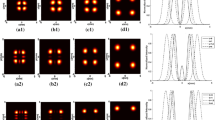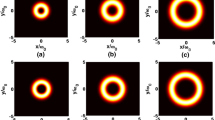Abstract
The longitudinal and transverse energy flux density (EFD) and angular momentum density (AMD) of a Pearcey–Gauss vortex beam in the far field are studied using the vector angular spectrum representation and stationary phase method, where the influence of topological charge, noncanonical strength and off-axis distance of the embedded optical vortex on far-field vectorial structures of the corresponding beam is emphasized. For comparison, the EFD and AMD of the Pearcey–Gauss beam with non-vortex in the far field are also discussed. The results show that the longitudinal EFDs of the Pearcey–Gauss vortex beam exhibit parabolic patterns, and the number of parabolic dark zones equals the absolute value of topological charge of the embedded optical vortex in the input plane. While for the Pearcey–Gauss beam, the dark zones are not found owing to the non-vortex in the input plane. The motion of zero-intensity spot of whole beam appears by varying the off-axis distance. Noncanonical strength and off-axis distance both can adjust the magnitudes and directions of transverse EFD and control the spatial energy distributions of longitudinal EFD, but not change the net AMD.







Similar content being viewed by others
References
Y. Hu, G.A. Siviloglou, P. Zhang, N.K. Efremidis, D.N. Christodoulides, Z. Chen, Nonlinear photonics and novel optical phenomena (Springer, New York, 2012), pp. 1–46
J.D. Ring, J. Lindberg, A. Mourka, M. Mazilu, K. Dholakia, M.R. Dennis, Opt. Express 20, 18955 (2012)
D. Deng, C. Chen, X. Zhao, B. Chen, X. Peng, Y. Zheng, Opt. Lett 39, 2703 (2014)
A.A. Kovalev, V.V. Kotlyar, S.G. Zaskanov, A.P. Porfirev, J. Opt 17, 035604 (2015)
Z. Ren, C. Ying, H. Jin, B. Chen, J. Opt 17, 105608 (2015)
M.V. Berry, C. Upstill, Prog. Optics 18, 257 (1980)
G.A. Siviloglou, D.N. Christodoulides, Opt. Lett 32, 979 (2007)
G.A. Siviloglou, J. Broky, A. Dogariu, D.N. Christodoulides, Phys. Rev. Lett. 99, 213901 (2007)
J. Broky, G.A. Siviloglou, A. Dogariu, D.N. Christodoulides, Opt. Express 16, 12880 (2008)
X. Chu, G. Zhou, Phys. Rev. A 85, 013815 (2012)
L. Zhang, F. Ye, M. Cao, D. Wei, P. Zhang, H. Gao, F. Li, Opt. Lett 40, 5066 (2015)
J. Baumgartl, M. Mazilu, K. Dholakia, Nat. Photonics 2, 675 (2008)
P. Zhang, J. Prakash, Z. Zhang, M.S. Mills, N.K. Efremidis, D.N. Christodoulides, Z. Chen, Opt. Lett 36, 2883 (2011)
Z. Zheng, B.F. Zhang, H. Chen, J. Ding, H.T. Wang, Appl. Opt 50, 43 (2011)
H.I. Sztul, R.R. Alfano, Opt. Express 16, 9411 (2008)
H.T. Eyyuboğlu, E. Sermutlu, Appl. Phys. B 110, 451 (2013)
Y. Dong, L. Zhang, J. Luo, W. Wen, Y. Zhang, Opt. Laser Technol 49, 1 (2013)
J. Huang, Z. Liang, F. Deng, W. Yu, R. Zhao, B. Chen, X. Yang, D. Deng, J. Opt. Soc. Am. A 32, 2104 (2015)
J. Zhou, Y. Liu, Y. Ke, H. Luo, S. Wen, Opt. Lett 40, 3193 (2015)
S. Nomoto, A. Aadhi, S. Prabhakar, R.P. Singh, R. Vyas, S. Singh, Opt. Lett 40, 4516 (2015)
F. Deng, D. Deng, Opt. Commun 380, 280 (2016)
P. Polynkin, M. Kolesik, J.V. Moloney, G.A. Siviloglou, D.N. Christodoulides, Science 324, 229 (2009)
Y. Gu, G. Gbur, Opt. Lett 35, 3456 (2010)
R.P. Chen, C.F. Yin, X. Chu, H. Wang, Phys. Rev. A 82, 043832 (2010)
Z. Ye, S. Liu, C. Lou, P. Zhang, Y. Hu, D. Song, J. Zhao, Z. Chen, Opt. Lett 36, 3230 (2011)
G. Zhou, R. Chen, X. Chu, Opt. Express 20, 2196 (2012)
F. Zhuang, X. Du, Y. Ye, D. Zhao, Opt. Lett 37, 1871 (2012)
X. Ji, H.T. Eyyuboğlu, G. Ji, X. Jia, Opt. Express 21, 2154 (2013)
C. Chen, B. Chen, X. Peng, D. Deng, J. Opt 17, 035504 (2015)
W. Wen, X. Chu, H. Ma, Opt. Commun 336, 326 (2015)
F. Deng, W. Yu, J. Huang, R. Zhao, J. Lin, D. Deng, Eur. Phys. J. D. 70, 1 (2016)
R. Martínez-Herrero, P.M. Mejías, S. Bosch, A. Carnicer, J. Opt. Soc. Am. A 18, 1678 (2001)
G. Wu, Q. Lou, J. Zhou, Opt. Express 16, 6417 (2008)
Y. Luo, B. Lü, J. Opt. Soc. Am. A 27, 238 (2010)
Y. Xu, G. Zhou, Opt. Laser Technol 44, 1318 (2012)
R.P. Chen, K.H. Chew, Laser Part. Beams 31, 9 (2013)
K. Cheng, L. Jiao, X. Zhong, Opt. Commun 367, 112 (2016)
T. Pearcey, Phil. Mag 37, 311 (1946)
G. Molina-Terriza, E.M. Wright, L. Torner, Opt. Lett 26, 163 (2001)
H.T. Dai, Y.J. Liu, D. Luo, X.W. Sun, Opt. Lett 35, 4075 (2010)
L. Mandel, E. Wolf, Optical coherence and quantum optics. (Cambridge University Press, Cambridge, 1995)
M. Born, E. Wolf, Principles of optics: electromagnetic theory of propagation, interference and diffraction of light. (Pergamon, New York, 2000)
D. Deng, Q. Guo, New J. Phys 11, 103029 (2009)
Acknowledgements
This work was supported by National Natural Science Foundation of China (Grant No. 61505075).
Author information
Authors and Affiliations
Corresponding author
Appendix A
Appendix A
The propagating electric field of a Pearcey-Gauss beam is given in Sect. 2 as
For the case of l = 0, in the paraxial case z-component of the above electric field can be ignored and the x-component can be further simplified to be
On the other hand, the analytical scalar representation of a PeG beam on a general transverse plane has been given in Ref [2]
where
and \(\zeta \left( z \right) = 1 + iz/z_{R}\) with z R =kw 0 2/2. In the far field, Eqs. (A3)-(A4) reduce to be
In the paraxial domain, the approximation is given by
substituting Eq. (44) into Eq. (43) and ignoring the term exp(ikr), the far-field vectorial Pearcey-Gauss beam obtained here equals the far-field scalar Pearcey-Gauss beam in Ref [2].
For a detailed derivation of a non-zero l, the far-field vectorial Pearcey-Gauss vortex beam can also be obtained by the same method.
Rights and permissions
About this article
Cite this article
Cheng, K., Lu, G. & Zhong, X. Energy flux density and angular momentum density of Pearcey-Gauss vortex beams in the far field. Appl. Phys. B 123, 60 (2017). https://doi.org/10.1007/s00340-016-6632-4
Received:
Accepted:
Published:
DOI: https://doi.org/10.1007/s00340-016-6632-4




